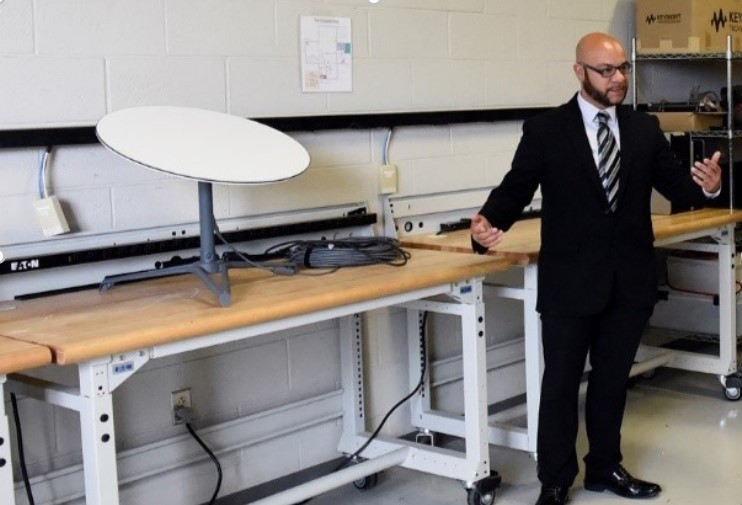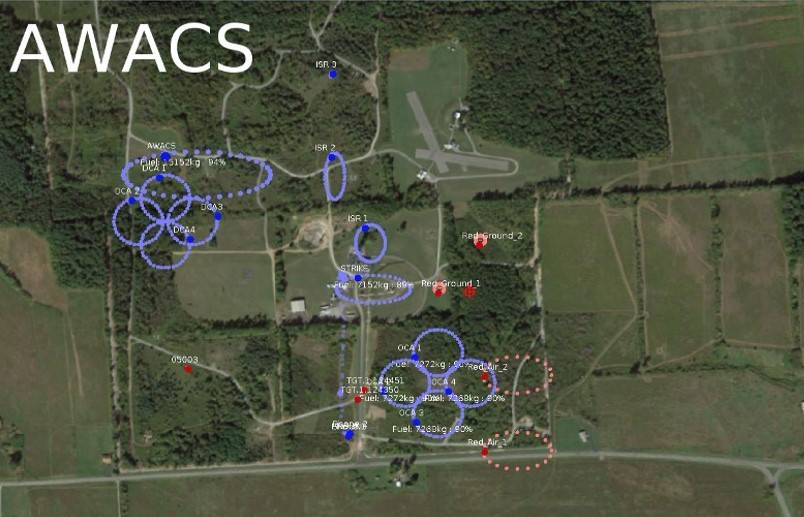ROME, N.Y. (AFRL) — The Air Force Research Laboratory, or AFRL, demonstrated its robust information provisioning layer, or RIPL, a cybersecurity tool that securely manages information across a network like ripples in the water, Sept. 8, 2022, at the Stockbridge Experimental Facility, a 300-acre site southwest of Rome, with a controllable contested environment.

Brian Holmes, an Air Force Research Laboratory program lead, discusses the robust information provisioning layer, or RIPL, system infrastructure in Rome, New York, Sept. 8, 2022. RIPL, a cybersecurity tool that securely manages information across a network, overcame limited and intermittent connectivity in contested environments during a September 2022 demonstration at the Stockbridge Experimental Facility. (Courtesy photo)
Brian Holmes, program manager of AFRL Advanced Planning and Autonomous Command and Control, or C2, Systems branch, said the demonstration, which included three of the four divisions with AFRL’s Information Directorate and two geographically separated locations, was “executed flawlessly.”
Teams from AFRL’s Information Directorate worked with industry partners including Raytheon and Starlink to advance this new information management networking technology.
Autumn is suitable for many changes in upstate New York, one of which involves lakes becoming placid to the point that every ripple is visible when a leaf impacts the surface. Those ripples inspired AFRL to develop RIPL, a system that allows seamless and secure access to content for all network users, ensuring users receive only what they request and are authorized to see.
By combining advances in artificial intelligence and machine learning with advanced disruption tolerance protocols, RIPL overcame the limited and intermittent connectivity in contested environments during the demonstrations. This is key for rapidly delivering critical content to those in need, such as warfighters on the front lines.
The demonstration showcased RIPL’s ability for the multidomain dissemination of different types of information across different networks seamlessly and transparently. Part of the demonstration included a secure Starlink connection between the Information Directorate Stockbridge Test Facility and the main Rome Research Site through the incorporation of High Assurance Internet Protocol Encryptors, integration with AFRL’s Agile Condor High-Performance Computing hardware, and integration with AFRL’s Baseline Road Assistance Tracker fusion algorithm.

An image showcasing how the robust information provisioning layer, or RIPL, system disseminates various types of information across multiple domains and different networks seamlessly and transparently utilizing the Starlink system. RIPL, an Air Force Research Laboratory-developed cybersecurity tool, was demonstrated Sept. 8, 2022, at the Stockbridge Experimental Facility, a 300-acre site southwest of Rome, New York. (Courtesy photo)
“RIPL advanced the goals of these organizations by providing mission and network-aware disruption tolerant information flows and distributed data stores, as well as increased information interoperability and information accountability and trust in contested environments,” Holmes said.
This demo supported Air Combat Command’s Combat Cloud Vision, the Air Force Life Cycle Management Center’s, or AFLCMC, High-Capacity Backbone Development Strategy and the AFRL Sensors Directorate’s Resolute Sentry program.
“RIPL enables the Air Force Combat Cloud vision, which in turn will be a key enabler of the U.S. Air Force’s Advanced Battle Management System, the service’s overarching effort encompassing technologies, operational requirements and warfighter integration efforts that will allow commanders and warfighters to share more and better information faster,” Holmes said.
“It also aligns with the Department of Defense’s Joint All Domain Command and Control vision and approach for identifying, organizing and delivering improved Joint Force C2 capabilities and accounting for adversaries who have closed many of the capability and methodology advantages depended upon for operational success,” Holmes added.
The RIPL technology demonstrated a capability for interoperability between the air and space domains and also supports the Department of the Air Force’s Operational Imperative, or OI, for ABMS/JADC2 by demonstrating redundant, resilient and seamless information exchange across airborne tactical data links, space data transport, and terrestrial communications.
The demo additionally supports the DAF OI for air, ground and sea surface moving target engagement through the integration of a mix of air and space-based capabilities that provide the resilient ability to conduct long-range, beyond-line-of-sight sensing and support integrated beyond line-of-sight fires against moving air, land and sea surface targets in a Joint and combined environment.
“It is just one small RIPL in the larger communications pond building a better network to connect the warfighter in the field,” Holmes added.
Continued work on RIPL is being conducted in Cambridge, Massachusetts by Raytheon/BBN in collaboration with AFRL to perform a deep analysis of the RIPL demonstration logs collected during the experiment and to create a simulation of the demo for digital experimentation within a controlled environment. Raytheon/BBN is also working with the AFLCMC Aerial Networks Division Common Tactical Edge Network Consortium, which is charged with the mission of developing aerial networking capabilities in support of the U.S. Air Force’s Advanced Battle Management System and Department of Defense Joint All Domain Command and Control programs that assist integrating RIPL into the architecture.
About AFRL
The Air Force Research Laboratory, or AFRL, is the primary scientific research and development center for the Department of the Air Force. AFRL plays an integral role in leading the discovery, development, and integration of affordable warfighting technologies for our air, space, and cyberspace force. With a workforce of more than 11,500 across nine technology areas and 40 other operations across the globe, AFRL provides a diverse portfolio of science and technology ranging from fundamental to advanced research and technology development. For more information, visit: www.afresearchlab.com.

